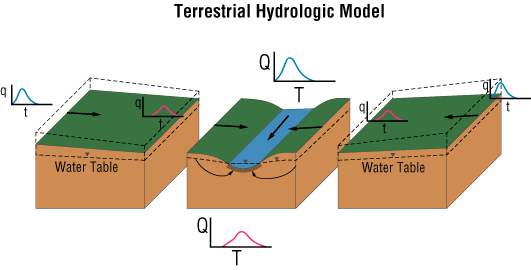
Terrestrial Hydrologic Model (THM)

THM was developed for the simulation of overland and channel flows (Johnson and Miller, 1997). Kinematic wave formulation along with flow-direction algorithm was implemented in THM to account for overland flow delay and storage on each grid cell. The advantage of kinematic wave approach is that it is less complex and it will not be limited in the model predictive ability regarding to the resolution and accuracy of the data sets. Muskingum-Cunge channel routing procedure is used to route the flow through the channel network from one grid cell to another, eventually to the outlet of simulated river basin. The procedure has capability to accommodate spatial parameters to each stream grid cell. The following form of kinematic wave method is used to describe the overland flow (Bedient and Huber, 1988).

In each grid cell, the block is discritized into many segments and the global time step is discritized into many smaller time steps. The finite-difference explicit solution of kinematic wave approximation of overland flow on each grid cell can be formulated as follow.

This formulation is used to derive overland hydrographs on each grid cell, which are added to produce collector hydrographs and, eventually, are routed to the channel or stream hydrographs. The relationship between the storage and discharge due to the routing is shown as follow.

Muskingum-Cunge method (Cunge, 1969; Bedient and Huber, 1988) was implemented in THM for the channel flow routing. The extended finite-difference form of this method can be written as follow.

The outflow hydrograph at the down-stream end of a given grid cell is calculated by the above equation (see Cunge, 1969 and Bedient and Huber, 1988 for detailed calculation). This procedure is applied on each stream grid cell to route the channel flow, through the channel networks derived from Digital Elevation Model (DEM), to the outlet of a river basin.
Comments and Questions
8/26/98